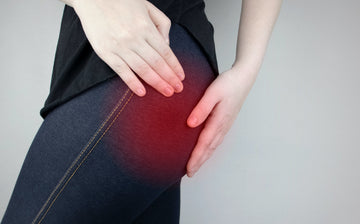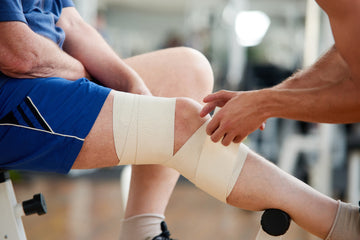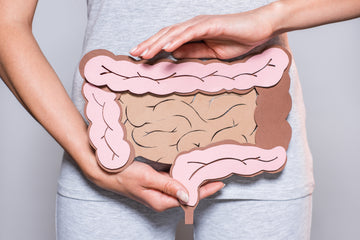Buttock muscle pain can be a debilitating condition that affects many individuals. Whether caused by muscle strain, overuse, or other underlying issues, it can significantly impact daily activities and quality of life. Fortunately, there are several effective methods to relieve muscle pain in buttock areas.
Today, we’re looking at how to relieve buttock muscle pain, its causes, different symptoms you may experience, and how to prevent buttock muscle pain in the future. Don’t let this condition keep you down. Learn how to relieve buttock muscle pain and get back to your normal life.
What Causes Pain in the Buttocks Muscle?
Before we dive into treating this ailment, let’s take a look at what causes pain in the buttocks muscle. There’s no singular cause for buttocks muscle pain. Instead, there is a wide range of triggers ranging from acute injury to underlying medical causes that may be affecting you. In order to successfully determine how to relieve buttock muscle pain, it helps to identify its source.
Some of the most common causes of buttock muscle pain are:
- Bruising: This kind of buttock muscle pain stems from acute injuries that have damaged the muscle temporarily. The coloring of bruises is caused by blood pooling underneath the skin from damaged blood vessels. Bruising as a source of muscle pain in buttock areas is often caused by falls or impacts from contact sports.
- Sciatica: While sciatica pain is actually a symptom of a pinched nerve, herniated disc, or another ailment, it is a common source of buttock muscle pain. Sciatic nerve pain commonly radiates from the lower back and down one leg, including the glutes.
- Muscle strain: Overexertion of the glutes can lead to muscle strain and muscle pain in the buttock area. This happens because the muscles are overworked and therefore tear. It can lead to other symptoms like swelling, tenderness, and limited mobility. Muscle strains can be caused by overdoing exercises, bad form while working out, or straining your glutes without being properly limber first.
- Poor posture: Practicing poor posture is a bad habit that will have you needing to learn how to relieve buttock muscle pain. Sitting incorrectly puts excess strain on the lower back, which may radiate down through the buttock area and cause discomfort.
- Bursitis: One of the more common underlying medical causes of buttock muscle pain is bursitis. This is when the fluid-filled sacs padding your bones become inflamed. Most often associated with joint areas, buttock bursitis — called ischial bursa — may cause pain when sitting or lying down. It’s a development found most often in those who may be sitting for prolonged periods of time.
There are many potential causes of muscle pain in buttock areas. Learning what causes pain in the buttocks muscle is key to identifying the source of your discomfort and treating it most effectively.
Types of Buttock Muscle Pain
Learning how to relieve buttock muscle pain also relies on knowing the different types of pain or sensations you may experience and differentiating them from other nearby catalysts. As there are different reasons you may experience muscle pain in buttock areas, knowing where the pain originates from aids in more efficient management and recovery.
The three most common types of buttock muscle pain are:
- Deep aches: Buttock muscle pain often manifests as a deep ache, characterized by a dull, throbbing sensation in your buttock muscles. This pain can be felt in one or both buttocks and may worsen with movement or prolonged sitting. It’s important to note that deep buttock pain can also be a symptom of other conditions such as sciatica or hip joint problems, so it's crucial to consider other symptoms you’re experiencing.
- Radiating pain: Pain that radiates down the back of the leg is commonly associated with sciatica. This pain can extend from the buttocks, through the thigh, and down as far as the calf or foot. Differentiating between buttock muscle pain and sciatica can be done by assessing the distribution and nature of pain. If the pain primarily radiates down one leg and is accompanied by tingling or numbness, it’s more likely related to sciatica.
- Numbness or tingling sensations: Numbness or tingling sensations, commonly referred to as "pins and needles," can present themselves alongside buttock muscle pain. If these feelings and sensations are primarily felt in the leg, it may be an indication of nerve compression or irritation. Differentiating between localized buttock muscle pain and nerve-related pain can be challenging, so consult your doctor to ensure an accurate diagnosis.
Identifying Buttock Muscle Pain From Other Nearby Pain
Where part of how to relieve buttock muscle pain is recognizing the feelings and sensations that may accompany it, there are some ways you can distinguish buttock muscle pain from other pains that may be sourced nearby.
- Location of buttock pain: Assess where the pain is primarily felt. Buttock muscle pain is usually localized to the buttocks, whereas pain radiating down the leg is often part of sciatica symptoms or nerve involvement. Treatment methods may overlap, but you’ll want to start at the source.
- Nature of your pain: Determining the type of feelings or sensations you’re experiencing with buttock muscle pain is important for identifying where, how, and when the pain began. It’s also part of differentiating buttock pain localized in that area from other sources of pain that may be radiating into the buttock area of your body.
- Additional pain symptoms: Don’t just stop at buttock pain. Knowing how to relieve buttock muscle pain most effectively requires you to recognize additional symptoms of pain you may be experiencing elsewhere in your body. Even if the connection may not be immediately apparent, the parts of our bodies are very connected and it may lead to a better understanding of your ailments.
If you’re experiencing symptoms that are severe or aren’t going away with simple home treatment, consult your doctor right away. A medical professional will be able to help more accurately determine the cause and any associated ailments for your buttock muscle pain and devise a treatment method. Seeing your doctor right away for any kind of pain is always best.
How to Relieve Buttock Muscle Pain Effectively
No matter what the cause may be, you want to know how to relieve buttock muscle pain quickly and effectively. This kind of pain can be debilitating, negatively impacting movement and keeping you from living your life normally. While more severe buttock pain may require advanced medical treatment, oftentimes you may be able to find buttock muscle pain relief at home or by making a few lifestyle adjustments.
A few methods for how to relieve buttock muscle pain effectively include:
- Ice and heat therapy
- Massage
- Stretching and exercising
- Lifestyle adjustments
Ice and Heat Therapy
Both ice and heat therapy may be effective methods for how to relieve buttock muscle pain. Ice is best applied right after an acute injury to reduce swelling and inflammation. Apply an ice pack affected area several times a day for 20–30 minutes at a time. Be sure to never apply ice packs directly to your skin, however, as it could damage the surface tissue.
The benefits of heat therapy to aid with how to relieve buttock muscle pain works to improve circulation and enhance the healing process. There are two types of heat therapy: moist and dry. Moist heat therapy methods include actions like taking a hot bath or using a steam sauna. Dry heat therapy methods are easier to apply throughout the day and may include tools like a heating pad or heated massage chair.
Massage
Massage is a highly effective approach for how to relieve buttock muscle pain and promote overall recovery. There are different methods to incorporate massage into muscle pain in buttock areas such as traditional massage therapy appointments, self-myofascial release techniques, and the benefits of an at home massage chair.
Traditional Massage Therapy
Traditional massage therapy performed by massage therapists can offer targeted relief for buttock muscle pain. Massage therapists are trained in various techniques and can customize the massage session based on individual needs. That said, it could be difficult to fit a massage therapy appointment into your busy schedule or to get one when you need it right away.
Self-Myofascial Release Techniques
If you’re experiencing discomfort you may also explore how to relieve buttock muscle pain with self-myofascial release techniques. By applying pressure to specific trigger points and tight areas, you can release tension and promote muscle recovery. Techniques like foam rolling target the buttock muscles and surrounding areas. Be sure to do self-myofascial release methods following proper technique and good form to avoid further injury or exacerbating the pain.
At Home Massage Chairs
The best way to help alleviate muscle pain in buttock areas is with an at home massage chair. Today’s luxury massage chairs have evolved and eliminated many of the differences between using a massage chair vs human massage. They offer a wide variety of massage techniques at the touch of a button from the comfort of your home and on your time schedule. L-track massage chairs continue the roller track beyond the lower back to the glutes and upper hamstrings, reaching everywhere you need.
Bonus massage chair features like heat therapy, chromotherapy, zero gravity reclining, and AI massage technology enhance the overall experience and may speed up recovery. The investment upfront also makes them more cost-efficient than ongoing massage therapy appointment expenses. You can experience the benefits of massage therapy at home for how to relieve buttock muscle pain and be back on your feet in no time.
Bonus Info: Learn more about the benefits of glute and butt massage after this article to see some of the things to consider when comparing S-track vs L-track massage chairs.
Stretching and Exercising
When it comes to learning how to relieve buttock muscle pain, self-care techniques like stretches, exercising, and ensuring you follow proper form are frequently helpful. These activities work to gently release muscle tension in the glutes and restore flexibility and mobility.
Some of the best stretches and exercises to do for buttock muscle pain include:
- Lunge stretch
- Butterfly stretch
- Seated pigeon stretch
- Quads and hamstrings stretch
It’s important to listen to your body as you do these stretches and exercises. Practice good form and don’t extend beyond your limitations as you’re healing. Pushing yourself too far before you’re ready could accidentally injure yourself further and set back the recovery process.
Lifestyle Adjustments
Sometimes you might find small lifestyle adjustments are effective for how to relieve buttock muscle pain. One of the common causes of muscle pain in buttock areas is sitting for prolonged periods of time. This often accompanies poor posture, a bad habit many of us are unaware we have.
Simple lifestyle adjustments such as taking regular breaks during work to stand and move around can make a positive impact on your overall health. It keeps your blood moving, engages your muscles, and prevents the stiffness that may accompany buttock muscle pain. Other ways of keeping active like taking up sports, going for a walk after dinner, or low-impact exercises like swimming are all beneficial for alleviating pain in the glute muscles and potentially preventing future incidents.
Preventing Buttock Muscle Pain in the Future
Now that you’ve got a better grasp on how to relieve buttock muscle pain after it starts, let’s discuss a few ways to prevent it from happening in the first place. After all, the best offense is a good defense.
A few simple ways to potentially prevent buttock muscle pain are:
- Practicing good posture: Good posture reduces strain on the buttock muscles, preventing pain and discomfort.
- Stretching before physical activity: Stretching before physical activities improves flexibility, and stability while reducing the risk of muscle imbalances or strains.
- Take breaks from sitting: Whether it’s a work break at the office or simply standing periodically while relaxing at home, frequent breaks from sitting alleviate excess pressure on the buttocks.
- Use proper lifting techniques: Lifting objects properly protects the buttock muscles from excessive strain or injury.
- Set up an ergonomic workspace: Ergonomic workspaces, such as those using ergonomic chairs or standing desks, improve posture and may help prevent buttock muscle pain from occurring.
- Stay hydrated: Drinking plenty of water helps maintain muscle function and prevents muscle cramps or stiffness, including buttock muscle pain.
As you’ve learned, there are a variety of methods for how to relieve buttock muscle pain. From early prevention to choosing a massage chair for home recovery, don’t let this potentially debilitating ailment keep you down. As always, check with your doctor before beginning any new health regimen to ensure it’s safe for you to do so.





